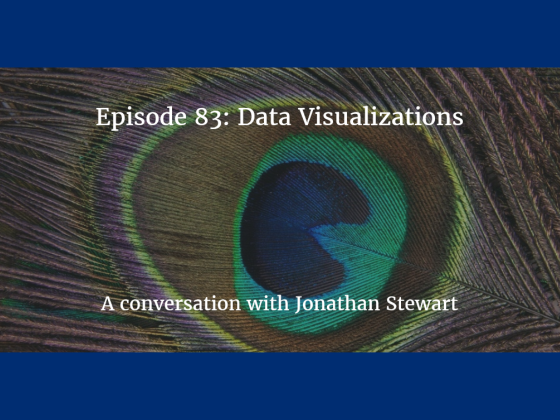Data Visualizations
We’ve all been there – you have some data and you need to make it pretty for the report. With the all the new reporting options you have probably been tempted to find a new way to visually present information. In this episode of the podcast, we are talking about data visualizations and our guest, Jonathan Stewart, has some issues with the way we currently go about it. Jonathan has been on the show as a panelist and I have really enjoyed his perspective on things so we invited him on the program to discuss some ways you can go about improving the data visualization of your reports, without adding additional burden on process.
Psychology plays a big role in data visualization. To make a good report, before even starting your tool, you should be able to summarize what the report presents. One of the major aspects of psychology is color and how we perceive it. Jonathan explains how we can use this while visualizing data. We discuss color blindness and I haven’t heard this discussed too much elsewhere and I was curious to know how we can solve this problem with an easy button.
Jonathan on Twitter
SQL Locks LLC
Edward Tufte and data visualization
Colour Blind Awareness
See you charts as a color blind person would
Building a data visualization storyboard
Episode Quotes
“One of the major aspects of psychology is just color, right? What colors you’re using? And this goes back to my storyboard and you see everything comes back to storyboard, right because that’s like. Actually I have everything done before I ever open a tool. Even the colors picked out should be done before I ever picked a tool.“
“Don’t think of it as, you know, I have to this extra work. Think of it as you’re doing it to prevent extra work. If you develop a framework, you develop your own storyboard and you get your stuff there“
“Out of 30 people in the room, there’s 3 people at least in that room that are colorblind. And then too, there’s not just one type of colorblindness. There are multiple spectrums.“
“We’re datafying everything. We datafy everything from our footsteps, to our calories, to our heart rate, to traffic on the road, we datafy everything because we like to be able to see and analyze things.“
“Are we using the numbers to prove our bias or we’re using the numbers to disprove our bias and to show the proper thing?“
Listen to Learn
- How to do a storyboarding before even opening a tool to create a report
- How to include storyboarding in data visualization process without investing too much time
- How you can prevent additional time spent on report modifications
- Color psychology behind data visualizations
- How to create a report that colorblind person can understand
- How the quality of the source data affects the end result
- Predictions how the reports and data will be used in the future
Our Guest

Jonathan Stewart
Jonathan is a SQL Server professional of 18 years. His experience ranges from BI architecture, data modeling, data warehousing, database architecture, database administration and strategic IT planning for Fortune 100 companies. He sees data in everything and is constantly looking for ways to organize, read and analyze whatever data set he can get his hands on. He is passionate about data and making sense of it. He is passionate about using data to effect positive change in his local community of Columbus, Ohio. When not doing data things, you can find him mentoring youth in his community.
Meet the Hosts

Carlos Chacon
With more than 10 years of working with SQL Server, Carlos helps businesses ensure their SQL Server environments meet their users’ expectations. He can provide insights on performance, migrations, and disaster recovery. He is also active in the SQL Server community and regularly speaks at user group meetings and conferences. He helps support the free database monitoring tool found at databasehealth.com and provides training through SQL Trail events.

Eugene Meidinger
Eugene works as an independent BI consultant and Pluralsight author, specializing in Power BI and the Azure Data Platform. He has been working with data for over 8 years and speaks regularly at user groups and conferences. He also helps run the GroupBy online conference.

Kevin Feasel
Kevin is a Microsoft Data Platform MVP and proprietor of Catallaxy Services, LLC, where he specializes in T-SQL development, machine learning, and pulling rabbits out of hats on demand. He is the lead contributor to Curated SQL, president of the Triangle Area SQL Server Users Group, and author of the books PolyBase Revealed (Apress, 2020) and Finding Ghosts in Your Data: Anomaly Detection Techniques with Examples in Python (Apress, 2022). A resident of Durham, North Carolina, he can be found cycling the trails along the triangle whenever the weather's nice enough.
Want to Submit Some Feedback?
Did we miss something or not quite get it right? Want to be a guest or suggest a guest/topic for the podcast?
